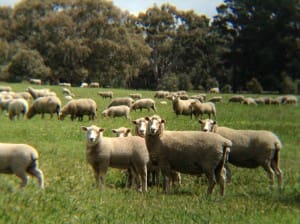MOST producers want their lambs to have a high growth rate, but focusing on just one profit driver can be counter-productive.
Using two on-farm trials, NSW Department of Primary Industries sheep breeding specialist Brent McLeod showed how using Australian Sheep Breeding Values (ASBVs) could make a prime lamb enterprise more profitable.
“Successful lamb producers near Glen Innes approached me with a problem,” he said.
“They had no trouble forward contracting their lambs and meeting target weights of 24–28kg HSCW (hot standard carcase weight); however, for four years in a row they were assisting 10% of their ewes during lambing and this was having a major impact on profits.”
Brent said most good operators in the New England aimed to keep their ewe losses to less than 3pc.
“After some discussion we decided on two trials. The first aimed to minimise ewe and lamb losses due to dystocia and the second investigated the difference in the value of lambs sired by rams with breeding values in the top 10pc PWT (growth – post weaning weight) compared to rams with industry average PWT,” he said.
Birthweight trial
Brent said mature ewes were randomly split into two groups. The first group was joined to rams with moderate birthweight ASBVs, while the second group was joined to rams from flocks that do not participate in LAMBPLAN.
All sires were visually assessed and selected on the same structural criteria.
The ewes were lambed in August/September and lambs marked late September. Records were kept of ewe assistance and lambing losses.
Brent said a replacement ewe was worth $200/head and a weaned lamb about $80/head (using the 2011 values at the time).
“This meant the cost of losing ewes and lambs from dystocia was about $320/ewe when the trial achieved close to 150pc weaning rates,” he said.
“A difference in 2pc in death rate between the groups represented a loss of 20 ewes or $4,000/1000 ewes joined without allowing for lamb losses.”
Growth rate trial
To investigate what impact selecting rams with high growth rate ASBVs had on profitability, Brent and the Glen Innes producers designed a simple on-farm trial. It compared two sire groups with LAMBPLAN breeding values.
Both groups had moderate birthweight figures; however, one had high growth rate ASBVs while the other had only average.
They were joined to separate groups of randomly selected matureage crossbred ewes from the same mob.
Brent said the results showed clearly why selecting rams with high growth ASBVs paid off.
“Their lambs were 5.1kg (liveweight) heavier at sale time which earned an extra $15 plus/lamb compared to the average growthrate- sired lambs,” he said.
“The trial averaged 100 lambs/ram joined which returned an extra $1500 per ram in the first year. I think the message is fairly clear.”
Brent said the trials not only solved the Glen Innes producers’ problems with dystocia, but showed them how to use ASBVs to easily improve their profitability.
“The simplest way for producers to increase their returns from lamb production is to minimise ewe losses through buying terminal sires with moderate ASBVs for birthweight, visually correct shoulder/ brisket structure and good ASBVs for PWT, so lambs are heavier at the same age of turnoff,” he said.
Source: MLA


Interesting work. Was there any reason that PEMD (muscle) & YFAT was not used for selection as these traits ( I believe ) assist in reducing birthweight whilst maintaining lamb survival?